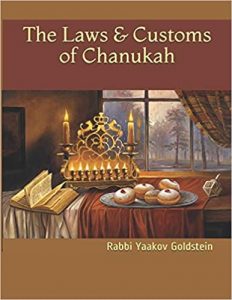
Question:
Our family is traveling out of town for one of the nights of Chanukkah and will be eating and sleeping in two different homes. We will be eating dinner by our relatives in the city although will not be sleeping by them that night and we will rather be sleeping elsewhere in the city. Where should I light the Chanukkah candles, where I am eating or where I’m sleeping?
Answer:
From the letter of the law, you can fulfill your obligation in either area. However, initially it is best for you to light the candles in the area that you and your family will be eating dinner. [However, if your family will remain in the area that you will be sleeping for the night and will not be eating dinner together with you by your relatives, then you should light in the area you will be sleeping where your family is found.]
Explanation: In previous times when the candle lighting took place by the door that faces the outside in order to publicize the miracle to the public, the main area for lighting was the area that one would be sleeping and not the area of eating. However, in today’s times that the custom has become to light inside the house and publicize the miracle to one’s family, the Poskim conclude that the main area follows the area of eating and not the area of sleeping. Accordingly, if one has a set home for eating and a set home for sleeping it is better for him to light in his eating home. Now, although the Achronim conclude that one who is merely eating out on one of the nights of Chanukkah must go back home to light candles in the area where he will be sleeping, this only refers to a case that one has a set home for eating and sleeping and is simply eating out on one of the nights, in which we say that that temporary eating area does not have the ability to override his set area of eating and sleeping. However, in our case that one’s sleeping area is also not set, as he is merely staying there for the night it ends up that for at least that night of Chanukkah, he does not have neither a set sleeping or set eating area, and hence both his sleeping area and eating area become of equal status, and in such a case the ruling is that today we mainly follow the eating area versus the sleeping area, and hence he should light at the area that he’s eating dinner with his family. However, all this only applies if he in truth is eating dinner together with his wife and children, in which case one can light by the dinner and publicize the miracle to his family. If, however, his wife and children remain in their sleeping area and do not join him for the dinner, then one should go back there to light and cannot light in the area of his dinner, due to reasons of Chashad, as explained in the Poskim. [However, in truth one can argue that in such a case, Chashad does not apply, as explained in M”B 677:11. Vetzaruch Iyun!] To note that all this follows the classic understanding of the major Achronim in the above Sugya, however, there are Poskim who novelize and rule that whenever one’s eating area is a distance from one’s sleeping area then one must light in the area that he is sleeping. According to this opinion it would end up that if one is not sleeping very close to the area that he’s eating dinner, then he must go back and light at his area of sleeping even if his family will be eating dinner with him.
Sources: See regarding lighting in the area of eating versus area of sleeping: Michaber 677:1; Tur in name of Rosh; Rashba 542, brought in Rama 677:1; Rashal, brought in Taz 677:2; Rama 677:1 and Taz 677:2 that we follow the eating area versus the sleeping area; M”B 677:11; Ateres Zekeinim 677:2 that if the two areas of eating and sleeping are a distance from each other, then he should light in the area that he will be sleeping. See regarding not lighting in a home where one is having dinner on one of the nights of Chanukah and the requirement to return back home in order to light: M”A 677:7; Taz 677:2 “Lighting by the meal would be similar to one who is lighting the candles in middle of the street, which of course has no relevance to the Mitzvah.”; Kneses Hagedola 677; Bach 677; Elya Raba 677:3; Peri Chadash 677; M”B 677:12; Biur Halacha 677:1 “Bemikom Sheochel”; Kaf Hachaim 677:17 and 21; Minchas Yitzchak 7:48; Kinyan Torah 5:72; Piskeiy Teshuvos 677:4 footnote 25 and 29-30; Az Nidbaru 7:69;



Leave A Comment?
You must be logged in to post a comment.